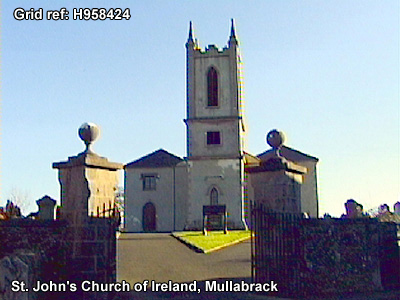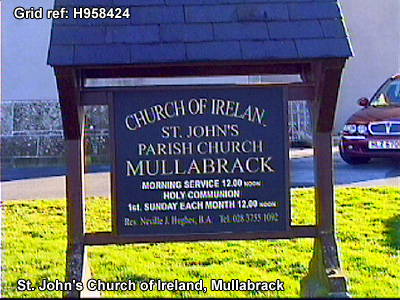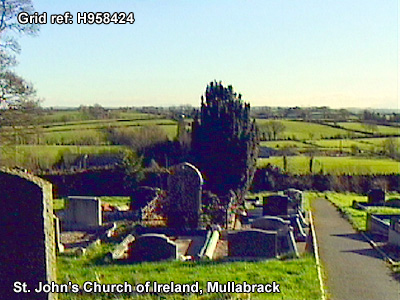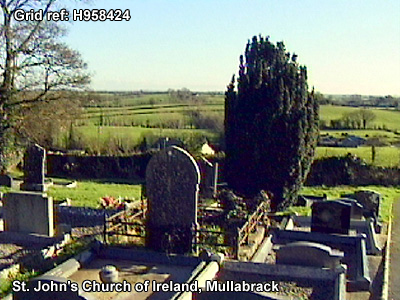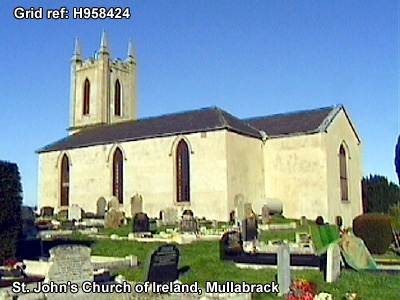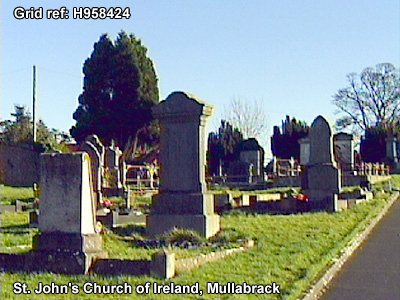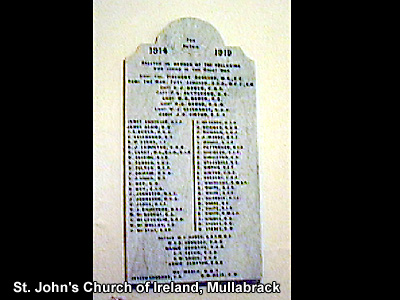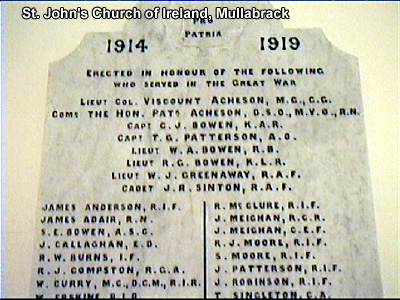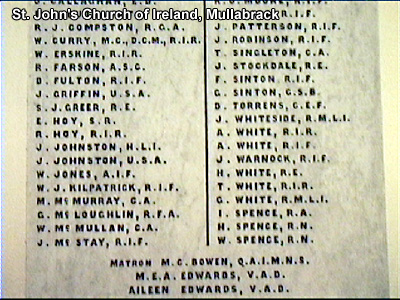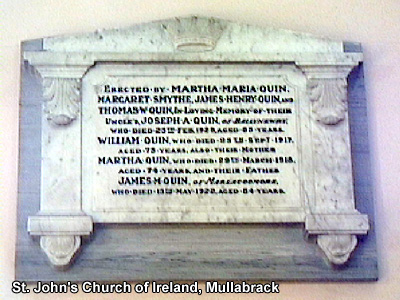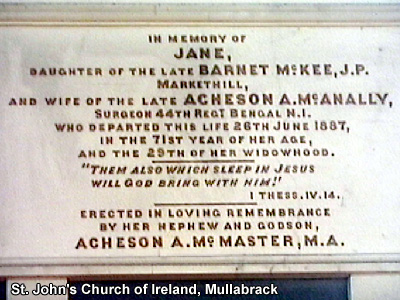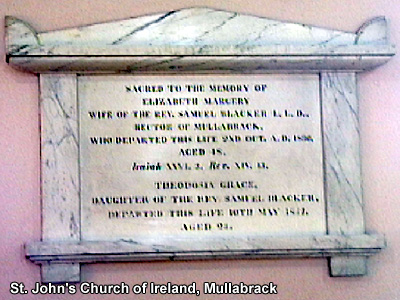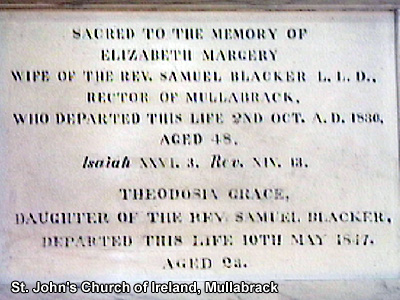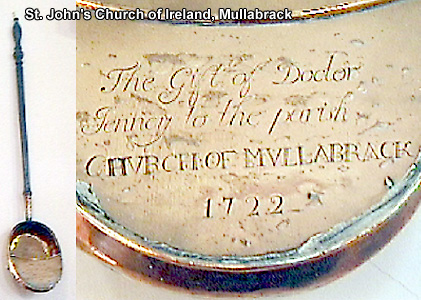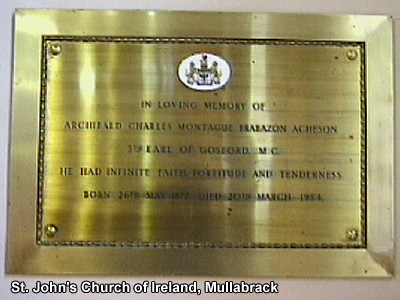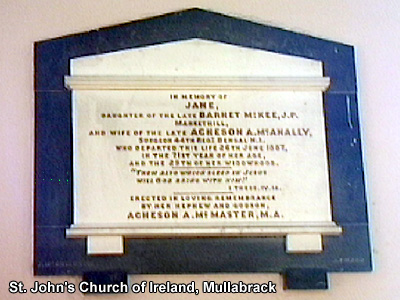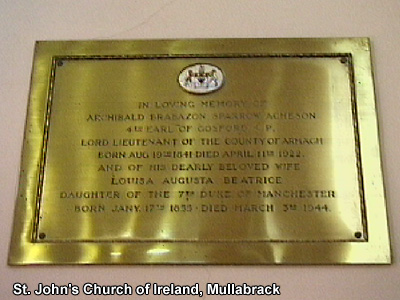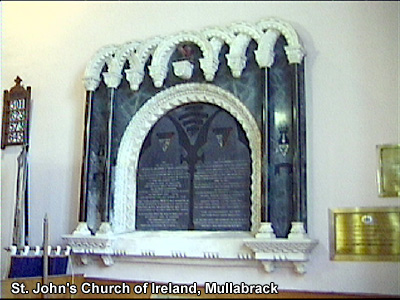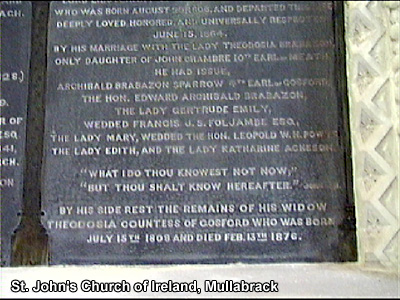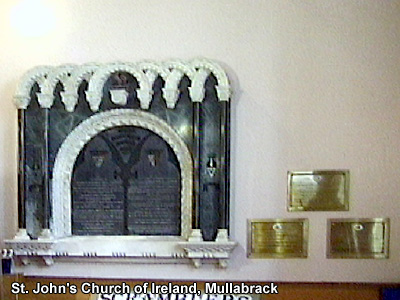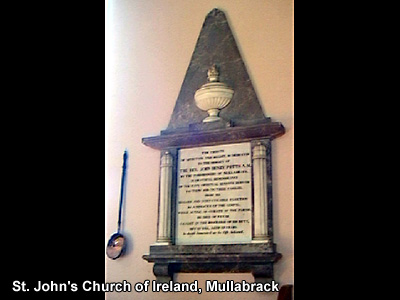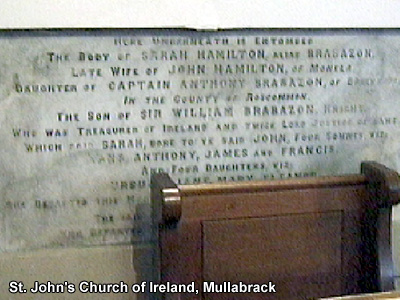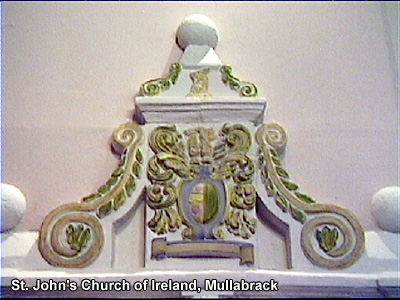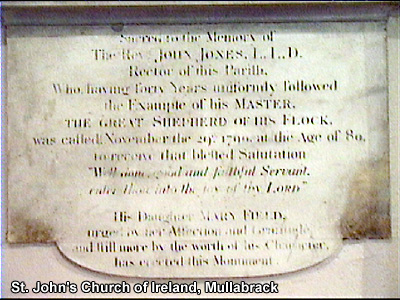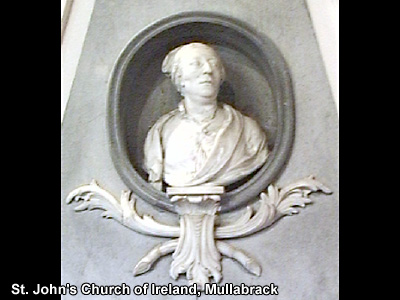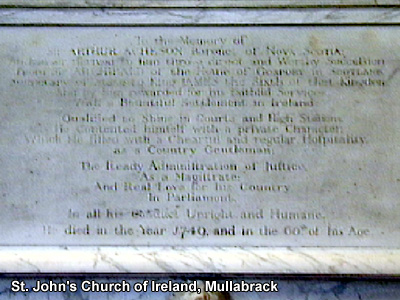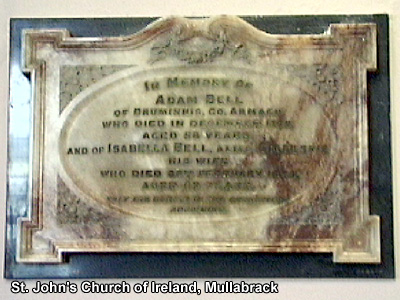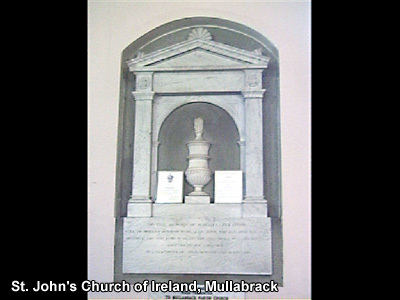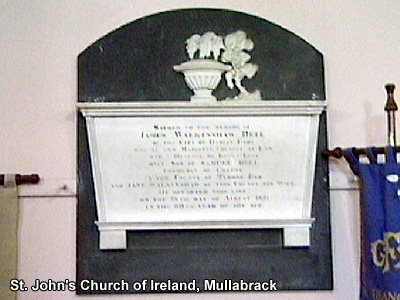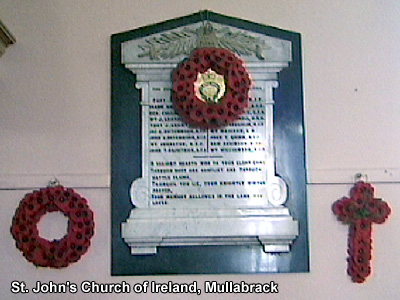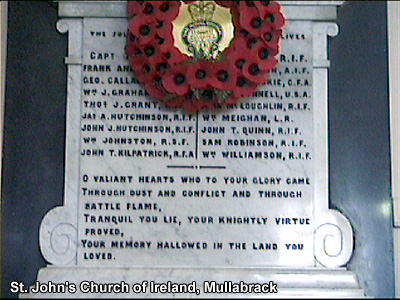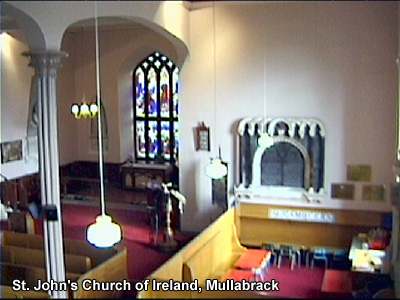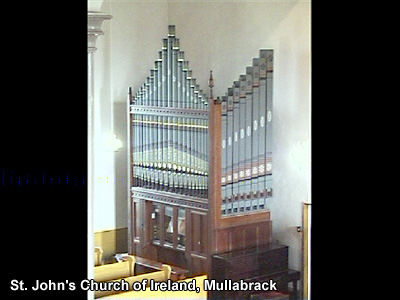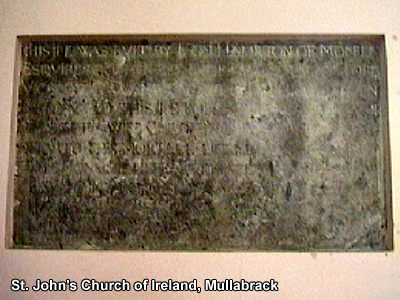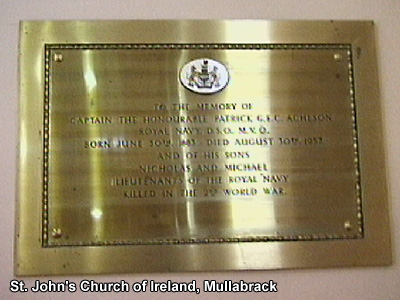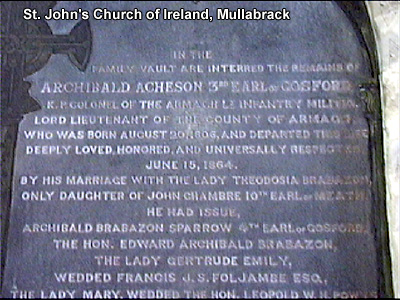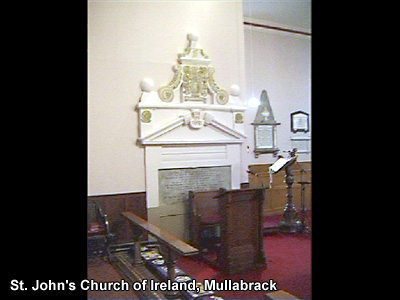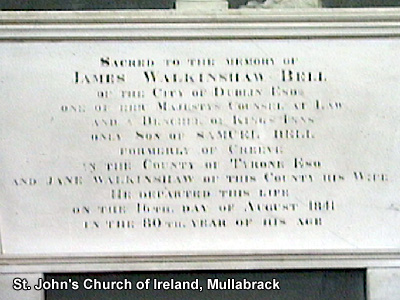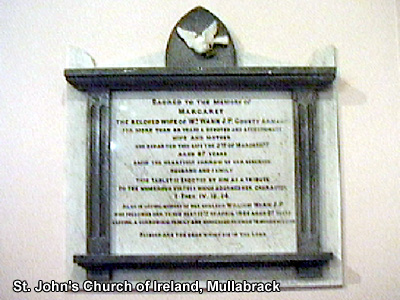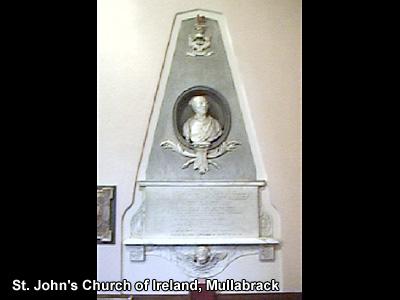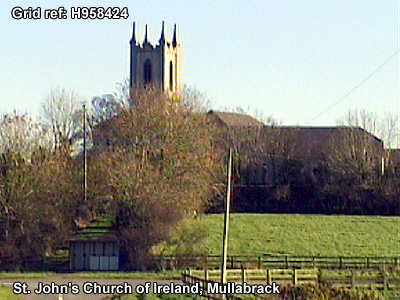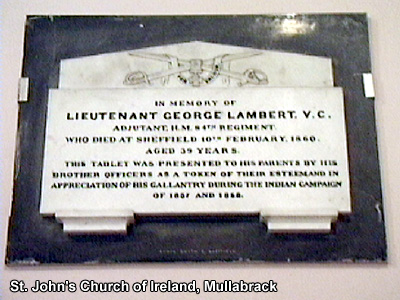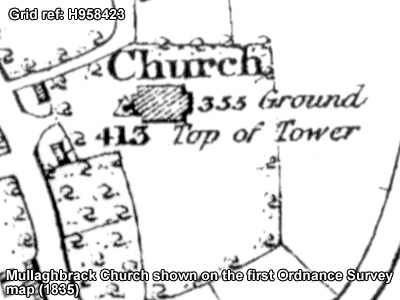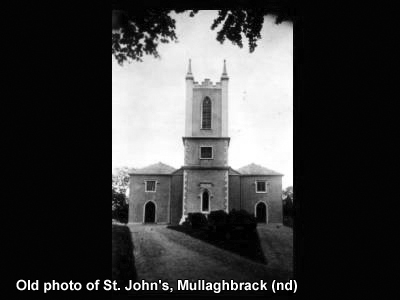ST.JOHN'S CHURCH OF IRELAND - MULLABRACK
The Church of Ireland Guide to St.John's Parish, Mullabrack, states,
"There has been a Christian Church on the rath or ringed fort at
Mullabrack (the name means 'hill of the speckled summit') for over a
thousand years. The first church, a small wooden structure, was founded
by the culdee monks and five different church buildings have occupied
this ancient site. The present church is very much the product of
extensive 19th century restoration and rebuilding which altered a simple
cruciform 18th century structure dramatically".
In fact, a gravestone found in the churchyard in 1928 suggests there was a Gaelic
centre of worship on this site pre-dating the culdees.
The origins of Mullabrack church as we know it today are closely connected with
the founding of St.Patrick's Cathedral in AD 444. The parish was originally in the
care of the culdees, the direct successors of Patrick. Nothing now remains of the
ancient culdee site. From earliest times it seems the Head of the culdees had a dual
role as Prior and Rector of Mullabrack. With the coming of the English, the culdees
were folded into the established church system and became the Vicars Choral of the
Cathedral in Armagh.
It would seem the Dean of Armagh held the Priorship until 1549, when the office
became obsolete as a consequence of the reformation. But, as late as 1608, the Prior
of Armagh was still titled the Parson of Mullabrack. The culdees continued to work
within the Cathedral and it was not until the Irish Church Act of 1869 that the
property was transferred from its original use.
Of the succeeding churches we know so little. It clearly appears on the map of the
Escheated Counties in 1609, but a Royal visitation of 1622 states the church "is not
wholly built" which could be an error for rebuilt. It was damaged in the violence 1641
and the curate, Rev.Mercer, murdered.
The Cromwelian Inquisition of 1657 stated the church was out of repair but it
seems to have been in good condition for a Primate's visit in 1693. Indeed it is given a
prominent position in Sir William Petty's acclaimed map of Co.Armagh, published in
1680. The inclusion of a church on a map of the area is not surprising. Travellers and
soldiers often used churches as points of reference in rural areas. The situation of
Mullabrack church lent itself easily to this purpose as it afforded views of the Belfast
Mountains, Dromara hills and the hills of south Armagh. In fact, a battle was fought
there on September 5th 1595.
By 1777 it was considered too small to accommodate the congregation but it was
not until the Rev.Blacker provided money in 1830 that the church was rebuilt,
significantly altering the cruciform layout of the eighteenth century building. In 1919
the chancel was tiled and a new font erected. The building as it existed in the 17th
century is engraved on the oldest chalice and paten.
The oldest monument was erected to the memory of Sarah Hamilton, the wife of
planter settler John Hamilton,
"This isle was built by John Hamilton, of Monela, Esq., brother to the Rt. Hon. the
Lord Viscount Claneboy. The said John Hamilton instituted this isle as a buryall place
for himself, his wife and children and posterity as they departed this mortal life near
the same. The monument being defaced in ye rebellion begun in Anno 1641 was
repayed by Sir Hans Hamilton, Knight and Baronet, son to the same John,
ano.1665".
Another memorial stone on the floor of the church commemorates 'James
Ayison', who dies in 1618. This could be a version of the surname Acheson and
therefore may commemorate the passing of one of the original Acheson settlers. In
fact the Acheson/Gosford vault is inside the church at Mullabrack. The last time the
vault was opened was in 1985 for the burial of Norah Acheson from Bournmouth.
The Gosford vault is unusual in that to gain entry to the crypt walls within the church
have to be breached, rather than the usual stone steps leading to a sealed door.
The church also contains a monument to George Lambert, Adjutant of His
Majesty's 84th Regiment and one of the earliest holders of the Victoria Cross.
There are also reminders of various epidemics through which the congregation
laboured. Reverends JH Potts and John Gibson both died of fever caught in the
discharge of their duty. In 1818, David McAnally, surgeon of the Armagh Militia,
saved 200 lives during a typhus epidemic before succumbing himself.
Some of the headstones are more amusing, as in this example, for instance: "Here
lies the body of Selina Williamson who nobly battled through life, paid all her debts,
and left the residue to her relatives".
Externally, the church is a simple symmetrical building with a tower in the centre,
flanked by two pointed doorways, above which are square, shaped windows. The
tower is roughcast with four corner pinnacles, and boasts a union flag.
The double-aisled interior design of the church is almost square in nature and
divided by cast iron pillars, supporting the ceiling on shallow arches. Five cast iron
columns support the gallery. The body of the church is filled with yellow-scumbled
box-pews. Perhaps a little out of keeping with the history of the building is the pew of
the Acheson family, which has now been converted into a children's play area.
LIST OF CLERGY
- 1613 John Hart
- 1629-1634 John Richardson
- 1634-1661 Henry Leslie
- 1661-1674 Henry Jenny
- 1674-1690 Christophilus Jenny
- 1690-1707 Henry Jenny
- 1708-1738 Henry Jenny
- 1733-1741 Caleb de Butts
- 1741-1779 William Godley
- 1780-1790 John Jones
- 1790-1815 James Archibald Hamilton (Primate Robinson appointed him first astronomer of Armagh Observatory - continued with dual role until death in 1815 - buried at Mullabrack)
- 1816-1826 John Jephson (died 1826)
- 1826-1849 Samuel Blacker (Gave in excess of £1000 to the building of a new church in 1830 - also used private funds to build a Glebe house in 1829)
- 1849-1859 Lord John de la Poer Beresford (On the death of his brother he became 4th Marquess of Waterford, died 1866) A tablet on the front of Markethill Chapel of Ease is inscribed:
"This Tablet is erected by the parishioners of Mullabrack in grateful acknowledgement of the munificent gift of this Chapel of Ease by their Rector, the Most Hon. and Rev.John de la Poer, Marquess of Waterford, on his retirement from the Incumbency, 1859".
- 1859-1875 Josiah Francis Flavell (died 1877)
- 1875-1905 John MacLaurin (Retired 1905, died 1910)
- 1905-1925 James Wilson Auchmuty (Resigned for the charge of Carlingford)
- 1926-1934 Henry Francis Osborne Egerton (Resigned for the charge of Dunany Union)
- 1934-1962 William George Kerr (Resigned for the charge of Moy)
- 1963-1975 Frank Arthur Noel (Resigned for the charge of Acton and Drumbanagher)
- 1976-1984 Clive West (Resigned for the charge of All Saints, Belfast)
- 1984-2000 Wallace Raymond Ferguson (Resigned for the charge of Carnteel)
- 2000- Neville Joseph Hughes
LIST OF CURATES
- 1633 James Stewart
- 1641 Mr.Mercer (Died in Rebellion of 1641)
- 1699 Alexander Shand
- 1720 William Bignell
- 1721 Thomas Rice
- 1737 Thomas Reid
- 1739 Squire Barker (Refused promotion and remained at Mullabrack until his death)
- 1739 Thomas Knox
- 1798-1807 John Young (Became Curate of Confeacle)
- 1811 William Barker (Became Rector of Newtownhamilton in the same year)
- 1816-1818 Henry Preston Elrington (Became Rector of Carlingford)
- 1819-1824 William Wray Craven (died 1924)
- 1826 Hugh Stewart (died 1878)
- 1826-1830 David Donaldson (Resigned for the Curacy of Tartaraghan)
- 1827-1833 Robert Charles Loftie (died 1833, buried at Ballymore Churchyard)
- 1830-1831 Edward Groome (Resigned to be Rector of Beaulieu)
- 1832-1835 John Henry Potts (died 1835, buried at Mullabrack) A tablet within the church reads:
"This tribute of affection and regret is dedicated to the memory of the Rev.John Henry Potts, by the parishioners of Mullabrack in grateful remembrance of the many spiritual benefits derived to them and to their families from his zealous and indefatigable exertions as a Minister of the Gospel. While acting as a Curate of the Parish he died of fever caught in the discharge of his duty, Nov.11, 1835, aged 33 years. In death lamented as in life beloved".
- 1833-1850 Robert Cordon Atkinson (Resigned to be Rector of Clonmore)
- 1837 Francis Tyrrell (Resigned to be Chaplain to the Earl of Ablemarie, London)
- 1838-1841 Henry Taylor Ringwood (Became Chaplain of Wilson's Hospital School, Co.Westmeath, died 1879)
- 1838-1839 William Raphael Williams (Became Curate of Newry, died 1867)
- 1841-1843 William Gray (Became a travelling minister and editor of 'The voice of S.America)
- 1843-1848 Charles Seaver (Became Curate of Kilbroney, died 1907) Two of his sisters, Alicia and Nicholina, died at his house in Markethill of the same day, April 13th 1847.
- 1844 John Wilson
- 1847-1848 Thomas Hanly Ball (Became Curate of Castlemacadam, Co.Wicklow, died 1877)
- 1849-1851 John Brien Frith (Resigned to become the Rector of Camlough)
- 1850-1851 James Twigg Wright (Became Perpetual Curate of St.Anne's, Derry)
- 1851-1854 William White Labarte (Became Curate of Enfield, Hants.)
- 1851-1867 Alexander Staples Irwin
- 1853-1855 Henry Charles Groves (Resigned to become Curate of Kilmore)
- 1855-1860 Edward Robert King Cummins (Became Curate of Flaxburton, Somerset)
1860-1867 John Joseph Gibson (died 1867) An inscription inside the church reads:
"Erected by the Rector and parishioners of Mullabrack in memory of the Rev.John Gibson, for more than seven years the faithful and zealous Curate of this Parish, who died at Markethill of typhus fever caught in the discharge of his duty, on the 18th February, 1867, aged 35 years".
- 1860-1864 Arthur William Irwin (Became a Chaplain in the East Indies)
- 1867-1869 John George Norton (Became Curate of St.Nicholas', Durham) Author of 'Hearty Services of Revised Church Worship' and 'Worship in Heaven and Earth'.
- 1967-1870 Henry Roper Taylor (Became Curate of Dunluce, Co.Antrim)
- 1869-1872 Leonard leader Sullivan (Became Rector of Mullavilly)
- 1871 John MacLaurin (Later became Rector of Mullabrack)
- 1873 James Lyons (Became Curate of Castlane, Carrick-on-suir)
- 1874-1876 William Hamerton
- 1896-1901 William Hogarth (Became Rector of Ballyeglish)
- 1901-1904 Leslie George Davis (Became Curate of St.George's, Halifax)
- 1904-1904 William Brown Allman (Became Curate in charge of Killeavy)
- 1952-1954 Roland Louis Hutchinson (Became Curate of Dromore Cathedral)
- 1956-1961 Henry James William Moore (Became Curate of Drumglass)
